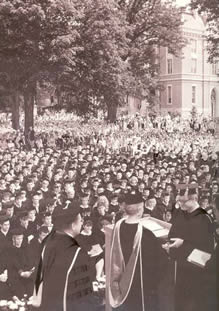
Pages:<<
Back 1 2
3 4 5
6 Next
>>
Appendixes:
Appendix A, Appendix
B

Despite
the remarkable transformation of DePauw University, especially during
the last one hundred years, DePauw students have remained largely
white, middle-class, and midwestern. Recent decades have seen important
changes in students' religious background, geographic residence,
and career patterns, but the social composition of the student body
and the patterns of student life have become perhaps even more homogeneous
and predictable since World War II.
During the first half of DePauw's history, the institution was relatively
small and recruited students chiefly from Indiana farms and small
towns. Total student enrollment grew steadily from just over 200
in the 1840s to about 400 in the 1870s. After the creation of the
new professional schools in the early DePauw years, student population
jumped to between 700 and 800 during the 1880s and 1890s. Only about
one-third to one-half of these students were engaged in college-level
work. The collegiate enrollment grew gradually from 50 students
in the 1840s, to just under 200 by the 1870s, to 300 students in
the 1890s, and around 460 during the next decade. Graduating classes
were even smaller with only seven students receiving degrees each
year in the 1840s, 16 in the 1860s, 45 in the 1880s, and 69 between
1900 and 1910. Small class size and the prescribed curriculum, which
insured that members of each class enrolled in the same courses,
maintained an intimate and personal social environment.


DePauw students in the 19th century had very similar backgrounds.
Probably three-fourths came from Methodist homes, and between 85
and 90 percent were Hoosiers, mostly from central Indiana. Antebellum
transportation was too expensive or, in many cases, unavailable,
preventing students from traveling long distances to obtain an education.
Students' families were part of Indiana's large rural and small-town
middle class that included successful farmers, shopkeepers, ministers,
lawyers, and doctors. Few were wealthy, even by 19th century standards,
but, as property owners, they enjoyed financial security and social
respectability and held positions of leadership in their communities.
Early DePauw graduates overwhelmingly entered the professions, just
as the northern middle class was shifting from property ownership
to education and professional training as the main basis of its
membership. Despite the university's close Methodist ties, only
one-fourth of its early graduates became ordained ministers. Of
all graduates between 1840 and 1905, in fact, just 16 percent were
ministers or missionaries while 22 percent were educators and 18
percent lawyers. Such a relatively low proportion of alumni in the
ministry may seem surprising for a 19th century church-related university,
but it clearly reflects the secular career orientation of its students
as well as the fact that most Methodist churches still did not demand
a highly educated leadership. Only 11 percent of the pre-1905 graduates
went into business, a career that eventually became much more attractive;
around one-fourth of the members of each class after 1910 found
employment in business and finance. Female graduates who sought
careers generally became teachers.
DePauw not only promoted its graduates' social mobility but also
trained leaders for the midwest's rapidly developing commercial
and urban society. A DePauw degree also enhanced geographic mobility.
Almost 65 percent of the 1900 and 1901 graduates were from Indiana,
but by 1920, only 42 percent still resided in the state and 23 percent
were living outside the midwest. By the 1950s, about half of the
alumni were no longer midwesterners.
Nineteenth-century DePauw students probably came from a broader
social base than is true today. Early DePauw was a remarkably open
institution. There was no tuition, and incidental fees were only
$24 per year in 1900. A room could be rented for $20 to $30 per
year and board was $2.50 per week. The college catalogues claimed
that $200 was sufficient to obtain a year's education at DePauw.
Many students, in fact, were self-supporting and financed their
education by taking odd jobs in Greencastle during the school year
and through summer employment.
Back
to Top
Pages:<<
Back 1 2
3 4 5
6 Next
>>
Appendixes:
Appendix A, Appendix
B
|

![]()
